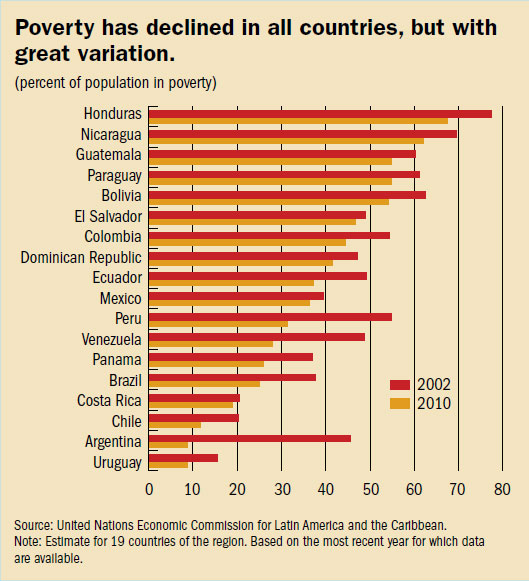Picture This
Growing Out of Poverty
Finance & Development, March 2012, Vol. 49, No. 1
Poverty in Latin America is at its lowest level in 20 years

POVERTY in Latin America and the Caribbean fell from 48.4 percent in 1990 to 31.4 percent in 2010, reaching its lowest level in 20 years, according to a new report from the United Nations Economic Commission for Latin America and the Caribbean. The rate of extreme poverty or indigence (a level of income that does not cover nutritional needs) also fell during this period—from 22.6 percent to 12.3 percent. Despite these achievements, 177 million people remain in poverty, including 70 million in extreme poverty. The report predicts a slight drop in the poverty rate in 2011, although the indigence rate could increase due to higher food prices.

Spending better on the poor
The main reasons for the reduction in poverty are strong economic growth, higher wage earnings, a decline in fertility rates, and better social programs. Efforts to reduce the effects on the poor during the 2008–09 economic crisis led to large increases in social expenditure and spending on public education. Total public spending increased by 3 percent of GDP during 2008–09 compared with 2006–07, and social spending increased by 2 percent of GDP over the same period. In the countries where social expenditure is less than $300 per person, the main expense is education. It is only in the relatively more developed countries (per capita social spending over $1,000) that social security and assistance account for more. But social protection systems are still far from inclusive, and large gaps remain—especially in access to social security.

Working smart
The decline in poverty is very good news, particularly in the midst of an international economic crisis. However, this progress is threatened by persistent productivity gaps and by labor markets that generate employment in low-productivity sectors without social protection. The ingrained differences between countries range from productivity asymmetries to significant differences in institutional development, access to international financial markets, and ability to generate national savings. Disparities within countries further complicate poverty reduction in the region. Continued progress in the fight against poverty will require greater efforts to improve access to education, upgrade cash transfers to the most vulnerable sectors, overhaul labor market institutions, and create inclusive social protection systems.



